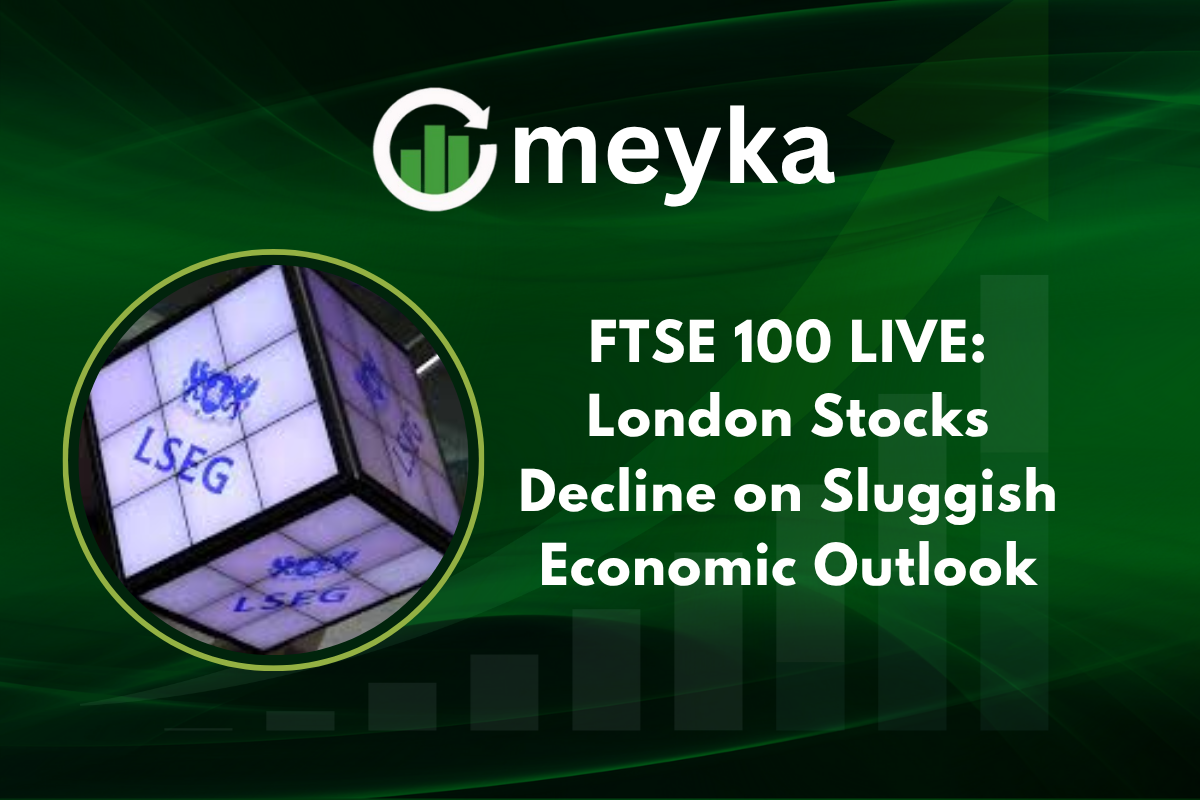FTSE 100 LIVE: London Stocks Decline on Sluggish Economic Outlook
London stocks fell as traders digested weak UK growth and mixed global cues. The FTSE 100 LIVE session showed modest losses after the UK economy grew just 0.1% in August. Whitbread led declines after a poor trading update, while cautious investors eyed the upcoming Autumn Budget.
The mood stayed fragile across European markets as investors weighed growth and policy risks.
FTSE 100 LIVE Market Overview
The FTSE 100 LIVE index slipped as risk appetite cooled. Traders reacted to the low UK GDP print and cautious company updates. Despite solid earnings from some US banks, London shares moved lower.
Investors focused on domestic weakness, not global strength. Whitbread was a large drag for the market, and energy and mining names also softened. The tone was cautious ahead of the Chancellor’s Autumn Budget.
Why did the FTSE 100 dip when US banks did well? Because local data matters for UK stocks, and weak GDP raises budget and rate worries.
What Dragged London Stocks Lower Today in FTSE 100 LIVE?
Several factors pushed the FTSE 100 LIVE lower today. First, Whitbread warned on near term demand, causing a sharp fall. The hotel and leisure group reported weaker revenue and profit outlooks.
This cut investor confidence in travel and leisure names. Second, UK centric sectors, like housebuilders and retailers, saw weakness. Third, low GDP growth raised the chance of tighter fiscal choices from the government. These combined to dampen markets despite better US bank results.
Why are investors cautious despite positive US earnings? Because the UK’s weak GDP of 0.1% in August shows local recovery is fragile. That matters for UK earnings and policy.
UK Economy’s Weak Outlook Hits FTSE 100 LIVE Sentiment
The Guardian reported that UK GDP rose by only 0.1% in August. This tiny increase signals a sluggish recovery and weak consumer demand. Investors worry the weak data could force tougher fiscal measures in the Autumn Budget.
If taxes rise or spending is cut, corporate profits and consumer spending may slow. That raises pressure on the FTSE 100 LIVE index which includes many UK sensitive stocks.
What does low GDP mean for the Bank of England and the FTSE? Low growth can keep the Bank of England cautious on cutting rates, which may limit market rallies.
How Global Markets Influenced FTSE 100 LIVE
Global cues were mixed and helped cap losses. US banks reported strong results, supporting risk assets elsewhere. That kept a floor under many global indices. Still, European markets were slightly weaker, mirroring the mood in London.
The FTSE slipped partly because it has heavy exposure to cyclical names like miners and banks. When growth worries rise, these names suffer more than defensive stocks.
Is the FTSE losing ground versus peers? The FTSE can lag when cyclical sectors face global growth worries, even if some US firms report good earnings.
Key Movers in the FTSE 100 LIVE Session
Here are notable moves from the session that shaped the FTSE 100 LIVE picture:
- Whitbread (-4.2% to -9% intraday), after weaker revenue and profit guidance.
- Barclays (-1.1%) and HSBC (-0.8%), softer on concerns over UK loan growth and margins.
- Shell (+0.6%) and BP (+0.5%), modest gains as oil prices stabilised.
- Diageo and Unilever showed mild strength, helped by steady global consumer demand.
These moves reflect the market split between defensive and cyclical exposures.
What Analysts Say About FTSE 100 LIVE Performance
Analysts noted the FTSE 100 LIVE drop is understandable given the data. Market experts said the 0.1% GDP print is too small to cheer. They also pointed out that investors now look to the Autumn Budget for fiscal clarity. Yet some see reason for caution not panic.
The index still benefits from strong dividend yields and global revenue from large multinationals. That gives the FTSE 100 LIVE some resilience even in weak local growth.
Do experts expect a long sell off? Most analysts say the pullback is short term, unless data keeps disappointing.
Investor Reactions and Market Sentiment in FTSE 100 LIVE
Investor sentiment turned cautious as trading volume slowed. Traders watched headlines and company updates closely. The Autumn Budget is now a focal point for fiscal risk and tax policy. Many investors are shifting to defensive names, and some are trimming cyclicals.
Retail investors may sit on the sidelines until clearer economic signs emerge. This mood shapes the FTSE 100 LIVE near term outlook.
Will the FTSE 100 bounce back soon? Recovery depends on upcoming data: retail sales, inflation, and the Budget details.
The Broader Picture for Global Investors Following FTSE 100 LIVE
Global markets remain fragile amid mixed signals. Asia showed mixed performance as China growth stayed weak. US treasury yields and Fed commentary also influenced risk appetite. Europe tracked UK caution to an extent, showing the cross market influence.
For global investors, the FTSE 100 LIVE offers exposure to strong dividends, but also cyclical risk. Many funds will watch central bank policy and corporate earnings for signs of a sustainable recovery.
FTSE 100 LIVE Outlook for the Coming Weeks
Looking ahead, investors will watch a few clear triggers for the FTSE 100 LIVE direction. First, the UK Autumn Budget will clarify fiscal policy. Second, upcoming UK inflation and retail data will show if consumer demand is firming.
Third, global earnings and interest rate signals will shape risk sentiment. If data improves, the FTSE could recover. If not, the market may stay in cautious territory.
What should investors watch next week? Keep an eye on inflation, retail sales, and any Budget hints from the Treasury.
Conclusion
The FTSE 100 LIVE session shows a market that is cautious and selective. Weak UK growth and disappointing company updates like those from Whitbread weighed on sentiment. Yet the index still has defensive strengths and strong dividend appeal.
As investors await the Autumn Budget and fresh data, the near term looks choppy. Markets may stabilise if growth signs improve and policy becomes clearer. For now, traders will watch data and headlines closely, and act with care.
FAQ’S
According to people, the FTSE 100 LIVE decline was mainly due to weak UK GDP data and falling shares in Whitbread. Google’s perspective highlights that poor economic growth and cautious investor sentiment continue to pressure the London Stock Exchange.
People say travel, retail, and banking stocks led the losses, with Whitbread and Barclays among the biggest decliners. Google views this as a reaction to sluggish consumer demand and global uncertainty affecting cyclical sectors.
Many investors believe the FTSE 100 LIVE will remain volatile until the Autumn Budget and key inflation data are released. Google suggests market sentiment will depend on how fiscal and monetary signals evolve in the coming weeks.
Disclaimer
This content is made for learning only. It is not meant to give financial advice. Always check the facts yourself. Financial decisions need detailed research.






